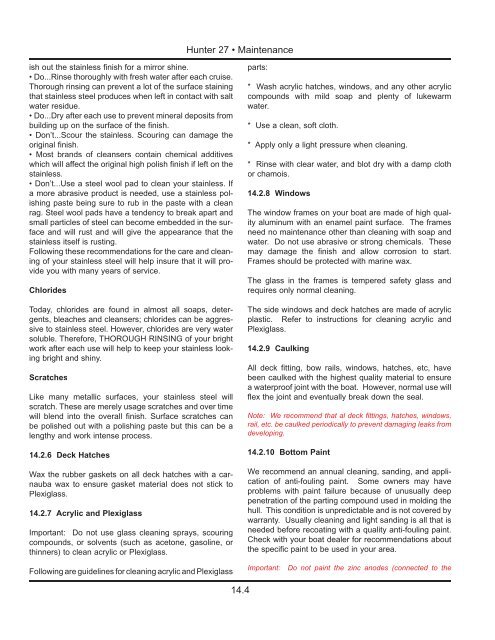27 Operator's Manual.. - Marlow-Hunter, LLC
27 Operator's Manual.. - Marlow-Hunter, LLC
27 Operator's Manual.. - Marlow-Hunter, LLC
Create successful ePaper yourself
Turn your PDF publications into a flip-book with our unique Google optimized e-Paper software.
<strong>Hunter</strong> <strong>27</strong> • Maintenance<br />
ish out the stainless finish for a mirror shine.<br />
• Do...Rinse thoroughly with fresh water after each cruise.<br />
Thorough rinsing can prevent a lot of the surface staining<br />
that stainless steel produces when left in contact with salt<br />
water residue.<br />
• Do...Dry after each use to prevent mineral deposits from<br />
building up on the surface of the finish.<br />
• Don’t...Scour the stainless. Scouring can damage the<br />
original finish.<br />
• Most brands of cleansers contain chemical additives<br />
which will affect the original high polish finish if left on the<br />
stainless.<br />
• Don’t...Use a steel wool pad to clean your stainless. If<br />
a more abrasive product is needed, use a stainless polishing<br />
paste being sure to rub in the paste with a clean<br />
rag. Steel wool pads have a tendency to break apart and<br />
small particles of steel can become embedded in the surface<br />
and will rust and will give the appearance that the<br />
stainless itself is rusting.<br />
Following these recommendations for the care and cleaning<br />
of your stainless steel will help insure that it will provide<br />
you with many years of service.<br />
Chlorides<br />
Today, chlorides are found in almost all soaps, detergents,<br />
bleaches and cleansers; chlorides can be aggressive<br />
to stainless steel. However, chlorides are very water<br />
soluble. Therefore, THOROUGH RINSING of your bright<br />
work after each use will help to keep your stainless looking<br />
bright and shiny.<br />
Scratches<br />
Like many metallic surfaces, your stainless steel will<br />
scratch. These are merely usage scratches and over time<br />
will blend into the overall finish. Surface scratches can<br />
be polished out with a polishing paste but this can be a<br />
lengthy and work intense process.<br />
14.2.6 Deck Hatches<br />
Wax the rubber gaskets on all deck hatches with a carnauba<br />
wax to ensure gasket material does not stick to<br />
Plexiglass.<br />
14.2.7 Acrylic and Plexiglass<br />
Important: Do not use glass cleaning sprays, scouring<br />
compounds, or solvents (such as acetone, gasoline, or<br />
thinners) to clean acrylic or Plexiglass.<br />
Following are guidelines for cleaning acrylic and Plexiglass<br />
parts:<br />
* Wash acrylic hatches, windows, and any other acrylic<br />
compounds with mild soap and plenty of lukewarm<br />
water.<br />
* Use a clean, soft cloth.<br />
* Apply only a light pressure when cleaning.<br />
* Rinse with clear water, and blot dry with a damp cloth<br />
or chamois.<br />
14.2.8 Windows<br />
The window frames on your boat are made of high quality<br />
aluminum with an enamel paint surface. The frames<br />
need no maintenance other than cleaning with soap and<br />
water. Do not use abrasive or strong chemicals. These<br />
may damage the finish and allow corrosion to start.<br />
Frames should be protected with marine wax.<br />
The glass in the frames is tempered safety glass and<br />
requires only normal cleaning.<br />
The side windows and deck hatches are made of acrylic<br />
plastic. Refer to instructions for cleaning acrylic and<br />
Plexiglass.<br />
14.2.9 Caulking<br />
All deck fitting, bow rails, windows, hatches, etc, have<br />
been caulked with the highest quality material to ensure<br />
a waterproof joint with the boat. However, normal use will<br />
flex the joint and eventually break down the seal.<br />
Note: We recommend that al deck fittings, hatches, windows,<br />
rail, etc. be caulked periodically to prevent damaging leaks from<br />
developing.<br />
14.2.10 Bottom Paint<br />
We recommend an annual cleaning, sanding, and application<br />
of anti-fouling paint. Some owners may have<br />
problems with paint failure because of unusually deep<br />
penetration of the parting compound used in molding the<br />
hull. This condition is unpredictable and is not covered by<br />
warranty. Usually cleaning and light sanding is all that is<br />
needed before recoating with a quality anti-fouling paint.<br />
Check with your boat dealer for recommendations about<br />
the specific paint to be used in your area.<br />
Important: Do not paint the zinc anodes (connected to the<br />
14.4

















